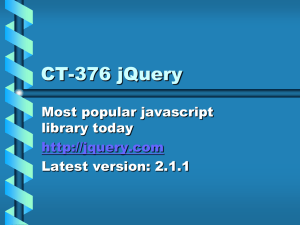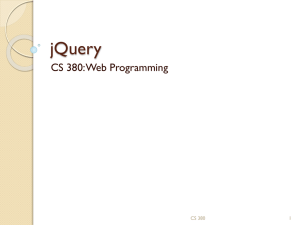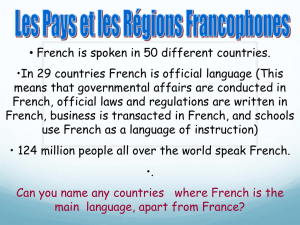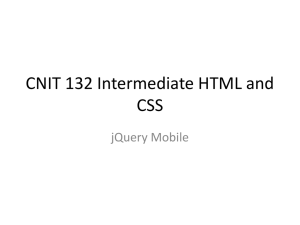jQuery - Web Programming Step by Step
advertisement
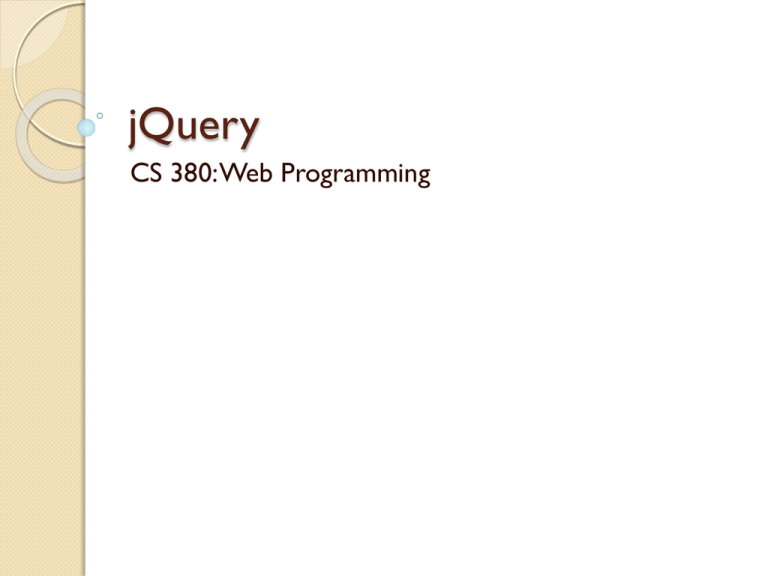
jQuery
CS 380: Web Programming
What is jQuery?
jQuery is a fast and concise JavaScript
Library that simplifies HTML document
traversing, event handling, animating, and
Ajax interactions for rapid web
development. (jQuery.com)
Why learn jQuery?
Write less, do more:
◦ $("p.neat").addClass("ohmy").show("slow");
Performance
Plugins
It’s standard
… and fun!
Example: Show/Hide Button
window.onload
We cannot use the DOM before the page
has been constructed. jQuery gives us a
more compatibile way to do this.
◦ The DOM way
window.onload = function() { // do stuff with the DOM }
◦ The direct jQuery translation
$(document).ready(function() { // do stuff with the DOM });
◦ The jQuery way
$(function() { // do stuff with the DOM });
Aspects of the DOM and jQuery
Identification: how do I obtain a
reference to the node that I want.
Traversal: how do I move around the
DOM tree.
Node Manipulation: how do I get or
set aspects of a DOM node.
Tree Manipulation: how do I change
the structure of the page.
The DOM tree
Selecting groups of DOM objects
name
description
getElementById
returns array of descendents with the
given tag, such as "div"
getElementsByTagName
returns array of descendents with the
given tag, such as "div"
getElementsByName
returns array of descendents with the
given name attribute (mostly useful
for accessing form controls)
querySelector *
returns the first element that would
be matched by the given CSS selector
string
querySelectorAll *
returns an array of all elements that
would be matched by the given CSS
selector string
jQuery node identification
// id selector
var elem = $("#myid");
// group selector
var elems = $("#myid, p");
// context selector
var elems = $("#myid < div p");
•
// complex selector
var elems = $("#myid < h1.special:not(.classy)");
jQuery Selectors
http://api.jquery.com/category/selectors/
jQuery / DOM comparison
DOM method
jQuery equivalent
getElementById("id")
$("#id")
getElementsByTagName("tag")
$("tag")
getElementsByName("somename")
$("[name='somename']")
querySelector("selector")
$("selector")
querySelectorAll("selector")
$("selector")
Exercise
Use jQuery selectors to identify elements with
these properties in a hypothetical page:
◦ All p tags that have no children, but only if they don't
have a class of ignore
◦ Any element with the text "REPLACE_ME" in it.
◦ All div tags with a child that has a class of special
◦ All heading elements (h1, h2, h3, h4, h5, h6)
◦ Every other visible li.
Use the DOM API to target the #square and
periodically change it's position in a random
direction.
Use jQuery selectors instead of the DOM API.
jQuery terminology
the jQuery function
refers to the global jQuery object or the $ function
depending on the context
a jQuery object
the object returned by the jQuery function that
often represents a group of elements
selected elements
the DOM elements that you have selected for,
most likely by some CSS selector passed to the
jQuery function and possibly later filtered further
The jQuery object
The $ function always (even for ID selectors) returns an
array-like object called a jQuery object.
The jQuery object wraps the originally selected DOM
objects.
You can access the actual DOM object by accessing the
elements of the jQuery object.
// false
document.getElementById("id") == $("#myid");
document.querySelectorAll("p") == $("p");
// true
document.getElementById("id") == $("#myid")[0];
document.getElementById("id") == $("#myid").get(0);
document.querySelectorAll("p")[0] == $("p")[0];
Using $ as a wrapper
$ adds extra functionality to DOM
elements
passing an existing DOM object to $ will
give it the jQuery upgrade
// convert regular DOM objects to a jQuery object
var elem = document.getElementById("myelem");
elem = $(elem);
var elems = document.querySelectorAll(".special");
elems = $(elems);
DOM context identification
You can use querySelectorAll() and querySelector() on
any DOM object.
When you do this, it simply searches from that part of
the DOM tree downward.
Programmatic equivalent of a CSS context selector
var list = document.getElementsByTagName("ul")[0];
var specials = list.querySelectorAll('li.special');
find / context parameter
jQuery gives two identical ways to do
contextual element identification
var elem = $("#myid");
// These are identical
var specials = $("li.special", elem);
var specials = elem.find("li.special");
Types of DOM nodes
<p>
This is a paragraph of text with a
<a href="/path/page.html">link in it</a>.
</p>
Traversing the DOM tree
name(s)
description
firstChild, lastChild
start/end of this node's list of
children
childNodes
array of all this node's
children
nextSibling, previousSibling
neighboring nodes with the
same parent
parentNode
the element that contains
this node
•complete list of DOM node properties
•browser incompatiblity information (IE6 sucks)
CS380
19
DOM tree traversal example
<p id="foo">This is a paragraph of text with a
<a href="/path/to/another/page.html">link</a>.</p>
HTML
CS380
20
Elements vs text nodes
<div>
<p>
This is a paragraph of text with a
<a href="page.html">link</a>.
</p>
</div>
HTML
Q: How many children does the div above have?
A: 3
◦ an element node representing the <p>
◦ two text nodes representing "\n\t" (before/after the
paragraph)
Q: How many children does the paragraph have?
The a tag?
21
jQuery traversal methods
http://api.jquery.com/category/traversing/
jQuery tutorials
Code Academy
http://www.codecademy.com/courses/you-andjquery/0?curriculum_id=4fc3018f74258b000300
1f0f#!/exercises/0
Code School:
http://www.codeschool.com/courses/jquery-airfirst-flight





